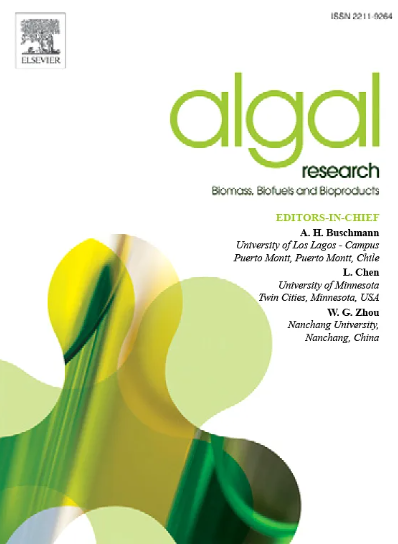Microfiltration of microalgae biomolecules: Impact of pulsed electric fields and high-pressure homogenization on single-cell protein recovery and membrane fouling
IF 4.6
2区 生物学
Q1 BIOTECHNOLOGY & APPLIED MICROBIOLOGY
Algal Research-Biomass Biofuels and Bioproducts
Pub Date : 2025-03-24
DOI:10.1016/j.algal.2025.104015
引用次数: 0
Abstract
This study investigated the separation of single-cell proteins from disrupted Auxenochlorella protothecoides microalgae using microfiltration. The microalgae were heterotrophically cultivated and subjected to two cell disruption methods, high-pressure homogenization (HPH) and pulsed electric field with incubation (PEF + inc), and stored at −20 °C. The impact of HPH and PEF + inc on the microfiltration performance of thawed samples was assessed. HPH treatment resulted in complete cell lysis, releasing a heterogeneous mixture of intracellular compounds. This, potentially combined with freezing effects, led to rapid membrane fouling and a 70 % decline in the permeate flux, finally stabilizing at 15 L m−2 h−1. In contrast, PEF + inc preserved cell integrity and particle size even after freezing, liberating mainly soluble compounds. This resulted in a more porous cake layer and a limited decline in the permeate flux, which stabilized at 24 L m−2 h−1. Additionally, higher protein transmission rates were achieved with PEF + inc (141.75 g m−2 h−1) than with HPH (54.53 g m−2 h−1) and it was 5.6 times more energy efficient. The cake layer formed by the HPH-treated samples had a higher resistance owing to smaller apparent pores and increased interaction with permeating proteins, which hindered protein transmission. These findings demonstrate that cell disruption methods can significantly influence downstream protein recovery efficiency and energy consumption. PEF + inc shows great potential as an energy-efficient bioprocessing method for microalgae biorefineries.

求助全文
约1分钟内获得全文
求助全文
来源期刊

Algal Research-Biomass Biofuels and Bioproducts
BIOTECHNOLOGY & APPLIED MICROBIOLOGY-
CiteScore
9.40
自引率
7.80%
发文量
332
期刊介绍:
Algal Research is an international phycology journal covering all areas of emerging technologies in algae biology, biomass production, cultivation, harvesting, extraction, bioproducts, biorefinery, engineering, and econometrics. Algae is defined to include cyanobacteria, microalgae, and protists and symbionts of interest in biotechnology. The journal publishes original research and reviews for the following scope: algal biology, including but not exclusive to: phylogeny, biodiversity, molecular traits, metabolic regulation, and genetic engineering, algal cultivation, e.g. phototrophic systems, heterotrophic systems, and mixotrophic systems, algal harvesting and extraction systems, biotechnology to convert algal biomass and components into biofuels and bioproducts, e.g., nutraceuticals, pharmaceuticals, animal feed, plastics, etc. algal products and their economic assessment
 求助内容:
求助内容: 应助结果提醒方式:
应助结果提醒方式:


